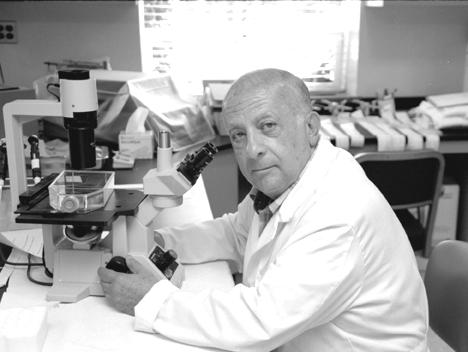The University Record, July 30, 1997
|
|
Hunein Maassab has collaborated with the National Institute of Allergic and Infectious Diseases on the flu vaccine since 1970. Photo by Bob Kalmbach |
By Debbie Gilbert
News and Information Services
A nasal spray influenza vaccine pioneered by Hunein F. Maassab, professor of epidemiology, has proven 93 percent effective in a major study of 1,600 children across the country. The vaccine triggers an early, local antibody response in the nasal passages–a powerful first line of defense and a key element in the prevention of influenza. School-age children are major carriers of the disease. Influenza kills 20,000 individuals each year in the United States alone.
The results of the 10-site study were announced July 14 by the National Institute of Allergy and Infectious Diseases (NIAID) and Aviron, the biopharmaceutical company in Mountain View, Calif., that licensed the vaccine technology from the U-M.
“The clinical trials demonstrate that the vaccine is safe, immunogenic, genetically stable and highly effective. It is very gratifying to see our years of effort pay off this way,” says Dr. Maassab, who has been collaborating with NIAID on the vaccine since 1973.
“This is a tremendous accomplishment,” says Noreen M. Clark, dean of the School of Public Health. “The results of the clinical trials are the successful culmination of three decades of dedication and innovation by Dr. Maassab and his research team. The vaccine is likely to have a major impact on U.S. public health in the future.
“Dr. Maassab’s work is a reflection of the continuing significance of the U-M Department of Epidemiology,” she adds, “which has been a powerhouse in vaccinology since the 1940s, when work on influenza and polio began.”
Maassab’s vaccine has three advantages:
- The vaccine uses weakened and harmless or “attenuated” live viruses that produce stronger and longer lasting immunity than that produced with the traditional dead virus vaccine.
- The vaccine is administered in a nasal spray that the children in the study “much preferred.”
“The tri-valent vaccine contains two different A influenza strains and one B strain, and protected children from both the A and B strains circulating last year,” Maassab says.
- The vaccine, which combines the core of the harmless influenza virus with the covering from a virulent strain, is highly adaptable. “The core virus can be stored until a flu epidemic breaks out and then ‘retrofitted’ with an outer covering that matches the virus causing the epidemic, Maassab explains.
Maassab, who was a research assistant of Dr. Thomas Francis Jr., founder of the Epidemiology Department, received his Ph.D. from the School of Public Health in 1956. Just four years later, he isolated the Influenza Type A-Ann Arbor virus and by 1967 had developed a cold-adapted virus that bred well in cooler nasal passages and did not mutate to more dangerous forms. From 1973 to the present, in collaboration with NIAID and more recently with Aviron, Maassab has been refining the vaccine and proving that it is not virulent to humans.
Aviron expects to file an application with the Food and Drug Administration next summer to license the vaccine for use in children and healthy adults.


